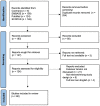Extensor Tendon Injury After Volar Locking Plating for Distal Radius Fractures: A Systematic Review
- PMID: 35168382
- PMCID: PMC9793626
- DOI: 10.1177/15589447211068186
Extensor Tendon Injury After Volar Locking Plating for Distal Radius Fractures: A Systematic Review
Abstract
Distal radius fractures are common orthopedic injuries. Treatment has varied historically, but volar locking plating currently predominates. Although flexor tendon injury is a well-studied complication of this operation, extensor tendon injury is less well studied. The purpose of this review is to search the literature and present the epidemiology, presentation, and treatment of this complication. The Cochrane, EMBASE, PubMed, and SCOPUS databases were searched for the terms "volar" + "radius" + ("plate" OR "plating") + "extensor." Ninety final studies were included for analysis in this review. The incidence of extensor tendon rupture varies from 0% to 12.5%; the extensor pollicis longus is most commonly ruptured. The presentation and management of extensor tendon injury after injury, intraoperatively, and postoperatively are summarized. Radiographic views are described to detect screw prominence and minimize intraoperative risk. Extensor tendon injury after volar locking plate for distal radius fractures is an uncommon injury with several risk factors including dorsal screw prominence and fracture fragments. Removal of hardware and tendon transfers or reconstruction may be necessary to prevent loss of extensor mechanism.
Keywords: anatomy; basic science; bone; diagnosis; distal radius; fracture/dislocation; research and health outcomes; specialty; surgery; tendon; treatment; wrist.
Conflict of interest statement
The author(s) declared no potential conflicts of interest with respect to the research, authorship, and/or publication of this article.
Figures


References
Publication types
MeSH terms
LinkOut - more resources
Full Text Sources
Medical

